“Meow” is just another name for “cat”
Jennifer Ball
Soochow University, Suzhou, China
Email: originofalphabet@me.com
How to cite this paper: Ball, J. (2019). “Meow” Is Just Another Name for “Cat”. Open Journal of Modern Linguistics, 9, 275-316. https://doi.org/10.4236/ojml.2019.95025
Received: May 9, 2019
Accepted: September 8, 2019
Published: September 11, 2019
Copyright © 2019 by author(s) and Scientific Research Publishing Inc.
This work is licensed under the Creative Commons Attribution International License (CC BY 4.0). http://creativecommons.org/licenses/by/4.0/
Abstract
Meow. We know this is the sound a cat makes. Five thousand years ago, so did the Ancient Egyptians. They called the cat “miw.” Mandarin Chinese speakers call the cat, “māo.” Three different cultures—Ancient Egyptian, Chinese, and Sumerian—used similar mechanisms to depict the meaning “cat,” and at least one version from each culture has a head, eyes, and tail. Humans have fought wars over religion, women, and body modification—but we agree on the word for “cat”? Humans are 99.9% identical, so we share similar biases, many based upon fertility. Bias creates pattern, pattern which could be harnessed to facilitate language acquisition. Recognizing the role that female mammals have played in ancient written languages is key to understanding the code that underpins human communication.
Keywords
Cat, Hanzi, Sinograph, Chinese, Ancient Egyptian, Hieroglyphs, Sumerian, Cuneiform
1. Introduction
Meow. We know this is the sound a cat makes. Five thousand years ago, so did the Ancient Egyptians. They just pronounced it “miw,” according to Sir Alan Gardiner, the deceased expert on Egyptian grammar. This is very close to how Mandarin Chinese speakers currently pronounce the word for “cat:” māo (Figure 1). Cats are important to humans. The 21st Pet Fair Asia had over 140,000 visitors and 200 “pure-breed” cats in 2018 (Xinhua.net, 2018)1. In the US, nearly one third of the population owns cats (AVMA, 2012)2. Cats outnumber dogs worldwide (Washington Post, 2014)3. National Geographic says that the oldest evidence of a “pet” cat was found in Cyprus inside a 9500-year old human grave (Pickrell, 2004)4. The remains of the cat, eight months old when it died, were 16 inches from the human remains. Almost ten thousand years later, owners still bury their pets and provide for the animals should the owners predecease them.

Figure 1. Highlighted in pink is the sound correspondence between the Chinese word for “cat” and Ancient Egyptian word for “cat.” A form of “meow” has been a signifier for “cat” for at least 5,000 years.
We can all agree that the cat is important, so is it surprising that many humans have a consistent name for a long-time associate? “The cat’s meow,” a now-hackneyed phrase from 1922 meaning “superlative” (Wikipedia, 2019)5 demonstrates that the sound which the cat appears to favor is a resonance we our- selves prefer. So then, why do so many of us call the cat “cat”?
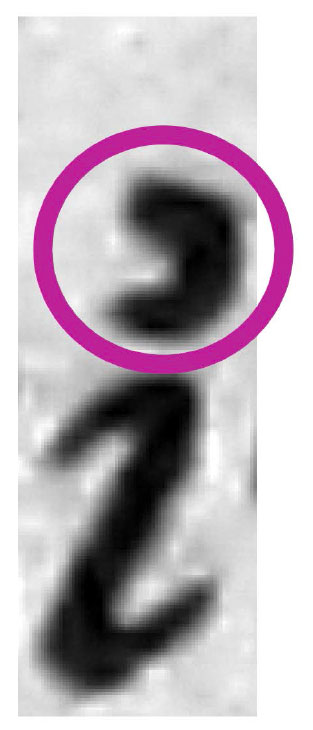
Figure 2. Curved tittle encircled in magenta. The distorted tittle is to communicate that the letter’s sound is somehow perverted—in this case from an “i” to a “y” sound.
To understand the complexity of the words that mean a “small, furry beast that purrs,” one must first comprehend the “tittle,” because in the arcane world of linguistics, there are still words that are throwbacks to the mindset of an earlier age, not dissimilar to Carl Linnaeus’ work on plants. The “i” you see in Figure 1 for the Ancient Egyptian word for “cat” is not really pronounced as an “i” but instead as a /y/ (“yuh”) sound. The tittle of the “i”—a tittle is the dot over an “i”—is curved (Figure 2) to show you that its sound is somehow perverted—in this case from an “i” to a “y”—so this word for “cat” really should be written as myw, which suggests that the Ancient Egyptian word for “cat” was probably not far from “mew,” another sound we recognize as emanating from a feline.
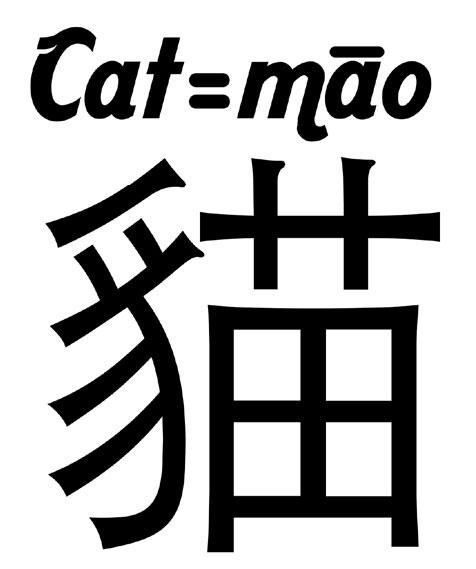 I apologize for bringing up curved tittles—and if the sound of this word makes you titter, it is not a coincidence. Our language is loaded with Cro-Magnon baggage, such as words and letters that show a similarity to sticks, weapons, and human body parts. We think our letters are not pictures. This is part of our myopia. The alphabet is a simplified form of what was important to early humans: things found in nature. Our letterforms are pictorial, but the pictures are so derivational that we’ve forgotten—as a society, and on purpose perhaps—what they represent. It is convenient to think that our alphabet is not as logographic as Chinese, for example (Figure 3), but that’s because many of us are in some form of denial, and perhaps even elitist: “Their language is pictures; ours is not.”
I apologize for bringing up curved tittles—and if the sound of this word makes you titter, it is not a coincidence. Our language is loaded with Cro-Magnon baggage, such as words and letters that show a similarity to sticks, weapons, and human body parts. We think our letters are not pictures. This is part of our myopia. The alphabet is a simplified form of what was important to early humans: things found in nature. Our letterforms are pictorial, but the pictures are so derivational that we’ve forgotten—as a society, and on purpose perhaps—what they represent. It is convenient to think that our alphabet is not as logographic as Chinese, for example (Figure 3), but that’s because many of us are in some form of denial, and perhaps even elitist: “Their language is pictures; ours is not.”
Part of the problem is this curved tittle. The way to keep people from knowing things is to use esoteric symbols or insufficient description. We also marginalize by deprecation. The “Bow Wow” theory, as it is known, postulates that the origins of speech are based on early humans’ imitation of animal sounds. You can guess by the name how seriously this theory is taken. “Onomatopoeia”—a word that sounds like the thing it names—is the term for the class of words that the “Bow Wow” theory covers. Words like “bees,” “crow,” “cuckoo,” and “hawk,” would appear to have been chosen after hearing an animal make that respective sound. “Meow,” though not recognized in our culture as a formal word, still signifies for most humans as the sound a cat makes. Onomatopoeic words are obvious choices for first vocalizations because the imitation of a sound takes only mimicry. It’s easier to copy than be original, and humans are good mimics. Perhaps an early speaker made the sound of a cat. An early listener understood what was meant was “cat.” It’s not difficult to imagine. Based on the Chinese and Ancient Egyptian words for “cat,” humans have heard and interpreted sound the same for at least five thousand years, and no doubt longer.
Linguists allow that there are similar-sounding words for some concepts across all cultures, but these congruencies are considered insignificant because they have their origin in onomatopoeia or else they fall into the category of “baby talk.” Wouldn’t those early words of children, uttered before the culture has had a chance to take a firm hold, more clearly suggest the origins of language? Should we discount words simply because they fall into the category of “too obvious”? Consider: Over the last 5,000 years humans have fought wars over religion, women, and body modification—but we agree on the word for “cat”? An irrelevant coincidence some linguists might say.
Are coincidences of this magnitude irrelevant? The congruence between sound and meaning over a five thousand-year period in three distinct cultures—Ancient Egyptian, Chinese, and our Western culture—for the concept of “cat” seems significant, especially because human evolution would be a logical explanation for this similarity. Humans have primal needs, and these needs dictate that human behavior follows patterns, much like children have characteristic stages as they grow (this could explain how the pyramids could exist in disparate cultures with no apparent contact between the creators). These human needs ended up imprinting similar characteristics globally upon our earliest vocalizations. The consonant-vowel pattern meow may not seem important in our language—it’s just the sound a cat makes—but in Chinese, this sound pattern—spelled “miao”—occurs 16 times by itself, and at least 78 times in conjunction with other characters, according to http://www.mandarintools.com. The Miao of China—one of the meanings of “miao”—is an ancient people known for their farming and embroidery; the word also means “family, progeny, sprout.”
The Oxford English Dictionary does not include a listing for “miao” or “meow.” The closest word is “miaow,” and it means, “Imitative. Similar representations of the cry of a cat (and corresponding nouns and verbs) are very widespread in numerous languages: compare, e.g., German miau, Spanish miau, Russian mjau, Turkish miyav, Finnish miau, Chinese miāo, etc.” Even though OED claims the word is widespread, the earliest date given is 1288. Ancient Egyptian isn’t mentioned. Under “cat” however, OED offers, “History points to Egypt as the earliest home of the domestic cat, and the name is generally sought in the same quarter.” Not discussed is the fact that the Egyptians used the word “miw,” even though Gardiner’s book was published in 1927.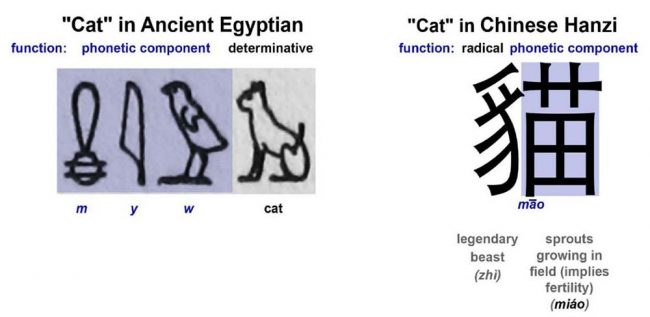
Figure 4. The cat is the “determinative” because it determines the meaning, though it contributes no sound. The sound comes from the three characters to its left.Meow transcends culture because so many cultures recognize this pattern of sound as signifying “cat.” Meow represents the concept of “cat” to a large number of people, even people who don’t think of the cat as “cat.” Mewing is an automatic way to communicate the concept of “cat.” Perhaps the fact that humans are more than 99.9% genetically identical (NIH, 2018)6 means we hear the same and think the same, so some amount of coherence exists between people, even if we haven’t been raised the same.
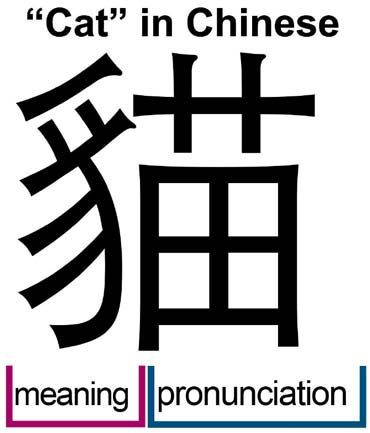
Figure 5. Ancient Egyptians and Chinese coded their words for sound and meaning. Both cultures depict “cat” with a picture of an animal and a key to the animal’s pronunciation. The cat-looking character on the left contributes no sound. The character on the right is considered the phonetic component and contributes the sound, though not necessarily with exactness. These two characters together are pronounced māo, but the phonetic component on right is miáo when alone.
Based upon the scripts of ancient languages, it appears that we have notated the same: Not only do Ancient Egyptians (Figure 4) and Chinese (Figure 5) share a similar sound for “cat,” their depictions share a similar structure. As you can see, both the hieroglyph for “cat” and the Hanzi for “cat” include meaning and pronunciation in their “words” that designate the meaning “cat.” In each language, the script for “cat” includes two levels of coding: content (meaning) and sound (pronunciation)—and in this case, both agree. Two ancient cultures not only pronounce the word for “cat” nearly the same, but they also graphically depict the concept of “cat” in a similar manner. However, this similarity takes an effort to see because they are so unalike pictorially. The Chinese and the Ancient Egyptians appear to have arrived at this strategy independently. Both cultures triangulated their written ideas by combining meaning and pronunciation in the same graphic in order to pinpoint the concept to be communicated, just like x and y coordinates mark a location on a graph (Figure 6). The underpinnings of the characters—the components that make up the “word”—aid understanding by adding content. The Hanzi character miao2 苗 in Chinese means “fertile.” The “w” sound in Egyptian was a chick, synonymous with new life. If we compare similarities in the scripts between the two ancient cultures, a focus on fertility is evident in both societies. When language was being created, procreation was a major focus of the culture, and this focus on sex was encoded into language.
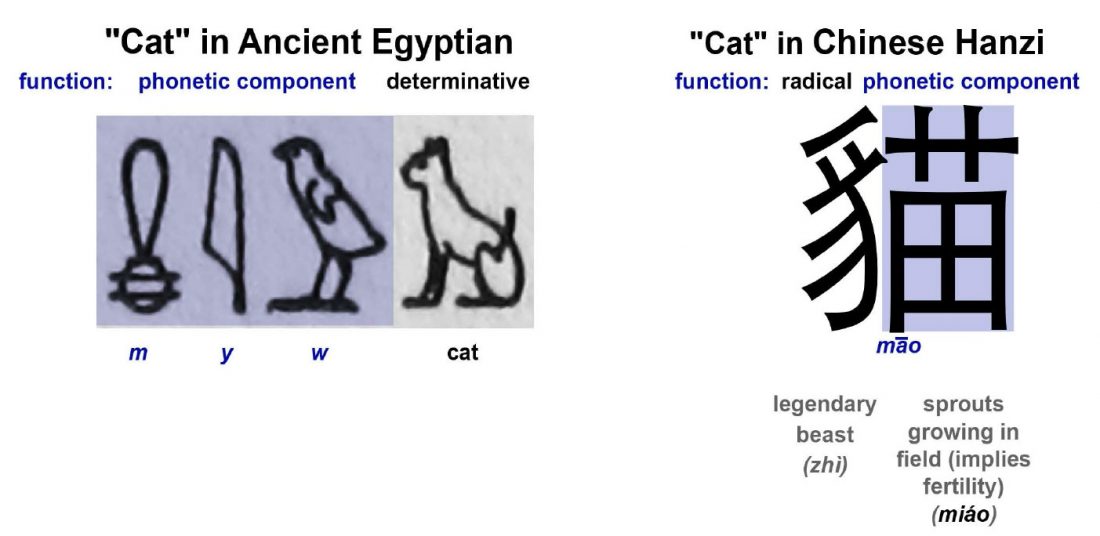
Figure 6. The similarity between Ancient Egyptian and Chinese: both use two coordinates—“ballpark” (determinative or radical) and “phonetic”—in order to define meaning.
2. Chinese and Egyptian both Have a Radical and Phonetic
The hieroglyphic cat on the left is easy to recognize, and we will come back to it in a bit, but first I will focus on the language spoken by more than one billion people: Chinese. The Chinese cat on the right is more stylized, however, one can still perceive two eyes, at least one whisker, the curvature of the animal’s back and rump, as well as the stripes for which some cats are known. The bottom curved line would seem to be a tail. Those stripes are probably not legs as this radical (a radical is a repeated component that carries meaning) is called a “legless insect” and a “legendary beast,” but they could also signify for hair as a cat is known for its fur. Metonymy tells us that one symbol can carry multiple meanings. This character 豸 is known as zhì (the character gives no sound to the pronunciation of “cat”) and is also occasionally known historically as a snake or a worm (both which have stripes or reticulation).
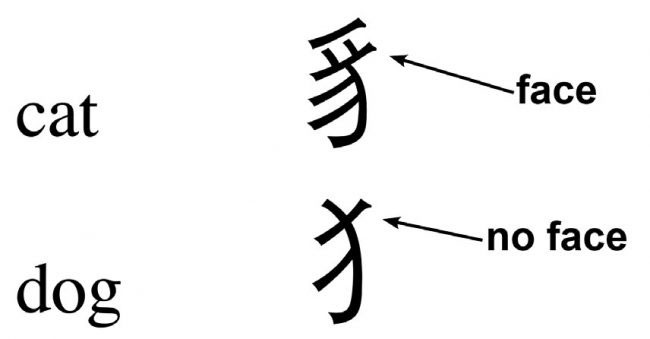
Figure 7. Humans typically don’t eat animals to whom they give faces. “Cat” has a face, but “dog” does not.It’s important to make clear that the descriptions different authorities attach to a particular Chinese character are interesting but misleading—the true test of what a character means is in the totality of the words in which the character is found. History tends to play up certain aspects—like leglessness in animals known for their agility—however, the boundary conditions that flavor the meaning of a particular Chinese character are formed by all the words that include that character. One method for categorizing what a particular character means is to organize the lexicon of words that have the character as a component. One can do this with many dictionaries, but the place I have done this is at http://www.mandarintools.com. If one enters the Chinese character for “cat”— 貓and searches “Traditional Chinese,” “match anywhere in dictionary field,” one will get 21 listings which include mostly cats and leopards, but also pandas (“bear cats”) and owls (“cat hawks”). This zhì 豸 animal—I will put the pronunciation and the Chinese character it represents together for clarity—stood not just for mammals, not just for fur, but for animals that were lovable predators. Fuzzy but with an agenda human could understand. Comparing the cat radical zhì 豸 with the “opposite dog radical” (as it is known in Chinese, because there are two dog radicals: 犬 and 犭, both pronounced quǎn), one notices that the traditional cat radical has a face. Humans typically don’t eat animals to whom they give faces (Figure 7).
The role that a radical plays in Chinese is the same role that the determinative played in Ancient Egypt (i.e., the cat is the determinative of this hieroglyph because it determines the meaning). Think of a radical as a category—the ballpark into which the sound you hear will fall. Both the Chinese and the Ancient Egyptian cultures used this ballpark-phonetic strategy, which combined content and sound together in order to communicate via writing. One could think of this strategy as a code. The key to cracking the code is to understand the culture that created it. Understanding culture helps one understand the logic behind the strategies. Triangulations are nothing more than two coordinates given together in order to hone in on an object; this method of locating something is a natural tendency of a strategic animal.
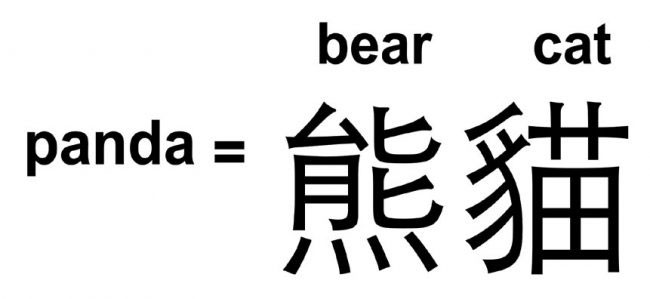
Figure 8. Metaphors are the method with which humans conceptualize new ideas. For example, a panda is a “bear cat” to someone who is familiar with bears and cats but unfamiliar with pandas.The Chinese language uses more than just the sound-content triangulations to determine meaning. It also uses two knowns to illustrate an unknown (Figure 8). For example, if your culture knows what a bear is and what a cat is but not what a panda is, a good way to describe one to a kinswoman would be by combining both ideas into a term, such as “bear cat,” which is what “panda” is in Chinese: xióng māo. The word “cat” is a kind of universal catchall meaning a “small living unit.” We have “cat” in lots of words. “Cattle” for example; this word, like “chattel,” comes from “capital,” which means “head” (where your cap goes). A “head” denotes one individual but often within a group of individuals, like heads of cattle. Even the word “category” signifies one of many. Cats are one of many: clones of each other; perhaps this is why we think they have nine lives—they look so alike, they appear to live forever. In elementary school, a “copycat” is a pejorative for one who copies another. Cats are famous for making copies—even children know this. Not only does the zhì 豸 radical suggest imitation because it looks like a cat, but when it is accompanied by miáo 苗, this sense of cloning is magnified because miáo 苗 depicts reproduction, both in its shape (note the bilateral symmetry) and in its most basic meaning that of a fertile field with grass growing, the quintessential metaphor for reproduction.
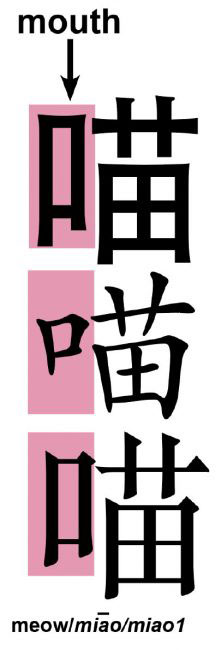
Figure 9. This character says to make the sound a cat makes (written in three different typefaces at 90 points).Miāo 喵—the Chinese depiction of that same fertile field accompanied by a character that represents a mouth—is duplicated in three different typefaces so that one can see the similarities between the different depictions (Figure 9). This character means “say this sound: miao.” This is the sound a cat makes in both Chinese culture and American culture. Notice that the character highlighted in red in all three examples is a kind of rectangle (more squarish in the middle). This is the mouth character (though sometimes it can simply represent an orifice), a common component of a Hanzi character, and in this case, it means the reader is to make the sound of the character on the right: 苗 (except use tone one).
Miāo or miao1 is the sound a cat makes (I will now write the tones with numbers in order to precisely delineate which of the four voiced tones—and one unvoiced—are meant). Miao1 is the pinyin pronunciation; pinyin is the spelling of Chinese sound in Roman letters (“Roman” is the style of letters with which I am writing this document). In pinyin, 苗 is miáo, and it has two sprouts or blades of grass growing on the top of a cultivated field. This field could be a rice field, but it is also metaphorical, so it is any fruitful pasture that signifies stability, home, progeny, and longevity.
Figure 10. The similarities between a European Family Crest, miao2 苗, and a Rice Field Crop include the outside boundary, the inside divisions, the foliage up top—bottom photograph by Hanuman Jatav.In analyzing the character miáo苗, one notices that the lines dividing the field into fourths could be a division of land or a stake in the ground—or both. Chinese is a cumulative language. In Chinese, a character which resembles a stake in the ground—shi2 十—means “ten.” Ten fingers are how one holds onto something tenaciously. That stake is in the center of the field, illustrating a tight grip: ownership. That cross also creates quadrants on the field which represent irrigation and cultivation (see Figure 10), as well as equity to subsequent generations as these divisions are even distributions of the land. Put a square around a stake and you have a symbol of possession. The sprouts growing over the divided land are symbolic of the beginning of life; they synecdochically imply sons (in a sexist culture, which all literate cultures seem to be, daughters are typically pawns to be bartered and not considered part of the future equation). The quartered field is a miniature chessboard, the boundaries defining one’s realm, the turf one must defend.
The English have a similar miniature checkerboard in the form of a family crest or coat of arms (Figure 10). It is often divided, occasionally into fourths; it also has bilateral symmetry. The plant growth, or mantling, which commonly emerges from the top of the coat of arms, signifies life and mirrors the sprouts which flower above the quartered field of miao2苗. The family crest depicts conquest with its helmet, castle, and lion, but the miao2 苗 character also has conquest inherent in the division of its land. The root character of miao2 苗 is tian2田—also roughly 3,000 years old—which is a field and means to “cultivate.” Cultivated land is a metaphor for Manifest Destiny, an idea embodied in the 19th century Caucasian conquest of territory but present in all cultures with writing, which is that land, plants, animals, even humans are there for the taking. When you’re focused on survival, such niceties—concern for others, for example—are not priorities. This field metaphor is seen in phrases like, “He’s sowing his wild oats,” where oats euphemistically stands in for semen—they are both seeds—and women are the implied “field” into which the protagonistic “he” is sowing. At http://www.usingenglish.com/reference/idioms, this phrase is defined as, “If a young man sows his wild oats, he has a period of his life when he does a lot of exciting things and has a lot of sexual relationships.” At http://www.urbandictionary.com, this same phrase is defined as, “To lead a promiscuous and self-indulgent lifestyle. Less stylistically, to nail lots of women before you settle down.”
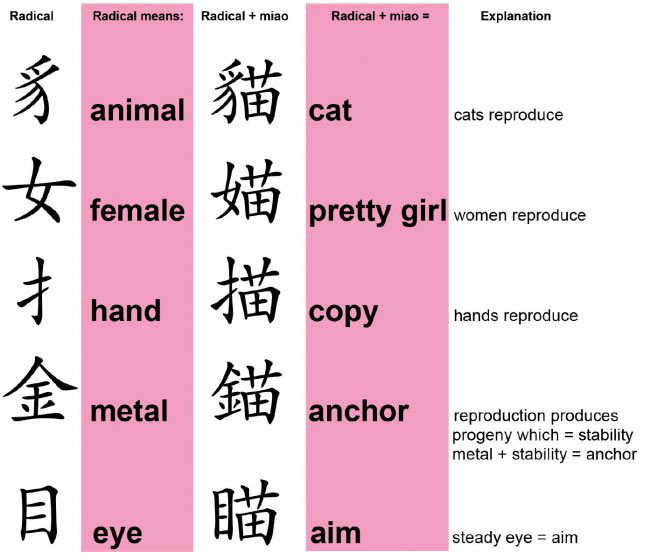
Figure 11. The stability of miao2 苗.“Nailing” is a key phrase, pinning them down and making them bear your babies. It’s all about reproducing because that’s how a culture survives. You can see this focus on reproduction in the table below (Figure 11). If you take the Hanzi character for “cat” and swap the animal radical 豸 for “female” 女 you get “pretty girl.” A pretty girl makes for a stable home life (theoretically) because she will bear you (the alpha male) children. Miao2 苗 represents stability because cultivated land is stable. Plants stay where you last left them because they have roots there; animals stay because someone cares for them and stables them; consequently, they produce offspring or copies. If you swap “female” for “hand” 扌, you get “copy” or “to trace” because now the hand is making the reproduction, not the woman. If you swap that same character for “metal” jin1 金 (that’s the shine of ore you see under the mountain), you get “anchor,” because “metal plus stability equals anchor.” If “eye” mu4 目 goes before the miao2 苗 character, the meaning becomes “aim” because a steady eye is needed for a good shot.
Aiming is what predatory animals do. They go after what they want. Man idolizes predators because man is a predator. A predator doesn’t always kill. Sometimes a predator dominates by passing on genetic material aggressively. Miao2 苗 is all about depositing procreative material and making copies. The structure of the Chinese written language is much more consistent than most people realize. The pronunciation component (yin1音bu4部) of a character also provides context. Miao2 苗 not only suggests the sound, the character pictorially suggests stability. This unrecognized aid to the meaning of a character is true of Ancient Egyptian as well (see the figure for a more in-depth analysis of Ancient Egyptian). Both languages use the pronunciation portion of a character as an additional semantic clue; this is in addition to the determinative/radical, which is already acknowledged by linguists to demonstrate meaning.

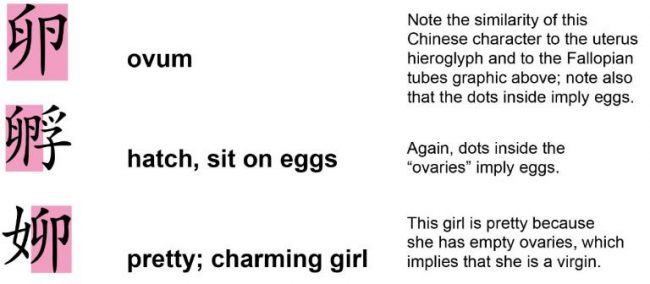
Figure 13. Comparing structures that resemble Fallopian tubes in Chinese Hanzi.Cats are linked to women in many cultures because of these same generative and stable qualities. Cats breed like rabbits, which, before women had access to The Pill, is identical to the fertility of most women. Statistically, we’ve all evolved to be fecund. This is why “cat” and “pretty girl” are both pronounced “mao,” with a slight difference of tone (this is similar to Hebrew where the difference in tone of למג means either “camel” or “to wean a child,” i.e., a mother; see “Breasts, Vaginas, and Tools: Musings on the Roots of our Alphabet” at https://originofalphabet.com). By referencing “cat,” the inference is fertility. One way of depicting fertility is metaphorical with a field; another way is more literal by actually showing the body parts required to be fertile: Fallopian tubes. Egyptians, Chinese, Sumerians, and Maya all used body parts in their scripts. Many people ask, “How did they know what Fallopian tubes looked like?” It’s important to remember that early human’s life was violent and gory. They took animals apart often, and that includes the human animal. Sacrifice was a bloody endeavor. The words “sacred” and “sacrifice” are related to the word “sacrum” (OED). The sacrum shelters the Fallopian tubes. The Fallopian tubes lead from the ovaries of female mammals—where eggs are produced—to the uterus—where an egg combined with sperm creates a new entity.
The illustration of Fallopian tubes is meant to be used as a reference for comparison to the Ancient Egyptian hieroglyph (Figure 12) and the Chinese characters underneath (Figure 13), since modern humans are less familiar with our insides than early humans were. The hieroglyph directly below the Fallopian tube’s illustration is the Ancient Egyptian hieroglyph for “bicornuate [two-horned] uterus of heifer,” “vulva,” and “cow.” The Chinese characters for “ovum” and “hatch,” both contain two dots in their Fallopian tube-resembling substructure. These are ostensibly eggs. Note also that “pretty; charming girl” has—adjacent to the “female” radical, which has a variety of forms (Figure 14)—a similar depiction to “ovum” but without the two dots; it would appear that a pretty girl’s Fallopian tubes are empty. Could a girl be pretty by the mere fact that she has no other male’s child in her womb? The proof of a woman’s virginity has historically been required in order to finalize a deal. The youngest girl in every fairy tale (including the Bible) is always the prettiest, perhaps because she is most likely to be a virgin.

Figure 14. Two examples of the character that means “female.” If you are unfamiliar with Hanzi, commit this shape to memory because “female” is in at least 2,864 characters, according to our research at www.HanziFinder.com.
3. A Focus on Fertility Helps to Decode Written Language
Using human evolution as one’s lens around which all language is filtered, a pattern begins to emerge that focuses on fertility and—consistent with the first 50 chapters of Genesis—preservation of seed. It’s easy to discount this theory if one has not read the beginning of the Bible or the histories and myths of early cultures. Women were a source of regeneration, and this was the focus of primal man because it allowed humans to build a work force or an army. It allowed them to see themselves in their offspring: Sons. They are the future around which all life radiated: a son is one’s sun. The desire for children is what unites men and women. Children soften the human existence. They make adults laugh because they are new to the world and everything is a wonder. They are the prototypical clown, wide-eyed and falling. They make one forget the ofttimes violent act that begets them.
Man has two sides: murdering and nurturing. Languages’ scripts reflect these two sides, but we don’t see it because we are still so motivated by sex and procreation that we are in denial: Facing our animalistic nature is too painful. If sex is important to us now (and I think we can safely say it is), imagine its significance before entertainment existed. Back then we had fire and sacrifice for excitement. Women were cloistered. The only way a male could get at them was to be very powerful and to conquer and pillage. One’s own women were off-limits unless there was an exchange of collateral and a sanctifying of the union. Another tribe’s women, however, were fair game. And I mean “game” in the sense of a game animal.
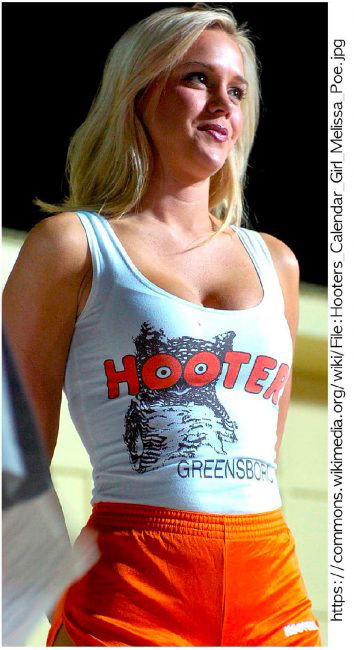
Figure 15. The Hooters logo includes a poorly drawn owl (now revamped) that is supposed to represent the word “Hooters,” but this word really refers to women’s breasts. This is an example of modern-day euphemism.
The focus on pretty girls has always been with us. When establishments like Hooters, an American restaurant chain that insists the name “Hooters” refers to owls, has 432 franchises (Hooters, 2018),7 this demonstrates that euphemism is thriving in 2019. The owl’s eyes in the Hooter’s logo are meant to represent the two “O’s” of the word “Hooters, and of course, owls “hoot” when they call to each other, but the word “hooters” is also a “double entendre” meaning “women’s breasts.” It’s the perfect cover: “Honey, it’s just owls. It’s not her large breasts that make me hoot.” But any conscious person who has been to Hooters knows that “T & A” is what Hooters is all about (Figure 15). This is not the first time in history that eyes and breasts have been correlated: eyes, breasts, they are both targets. An instinctual desire for large breasts has driven sexual selection because “bodacious tatas” suggest ample milk for a future generation.
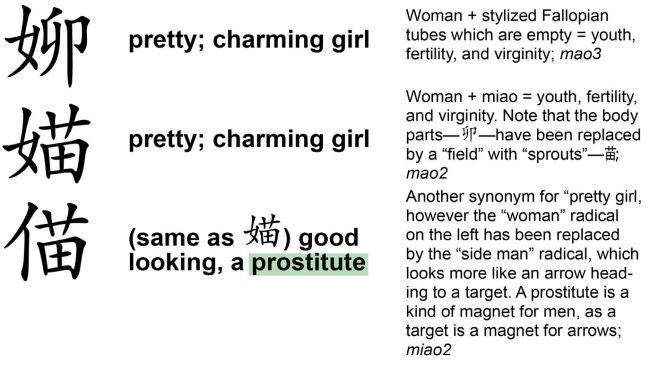
Sex is everywhere in society, why wouldn’t it be in language? Language was written at a time when procreation was the major focus of all cultures. In Chinese, there are at least three ways to write “pretty girl” (Figure 16), and one of them, miao2㑤, means “prostitute” as well (note also the similarity in sound and in spelling between the word “Hooters” and “hookers”). This character miao2㑤 includes the fertile field miao2 苗. Why would the breeding potential of a prostitute be important to someone having sex for money? Because fertility suggests youth, men have evolved to be attracted to youthful women because that is the way the genes are most likely to replicate. Menopause is nature’s way of telling men to move on to more fertile women—but before you get riled, consider that we hardly ever listen to nature—we live past 30, we take antibiotics, we fly in airplanes. Fortunately these days, the appearance of fecundity isn’t the only thing driving relationships.
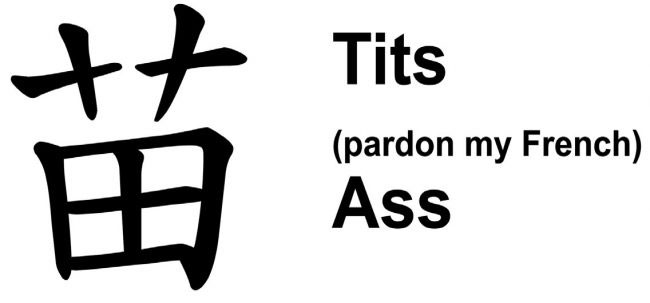 Miao2 苗 is clearly a complex character. As I consider how many ways it represents females, I wonder if this symbol could have other meanings (Figure 17). Could it too—like the Fallopian tubes—be a replication of female body parts? Could the miao2 苗 symbol represent “tits” (the two “t”-like upper parts that are often linked) and “ass” or “vagina” (the lower square with the plus in it that functions as a target)? A common symbol for women includes a plus sign: . It isn’t difficult to see this miao2 苗 character as signifying female anatomy when we know that it is linked to the word “prostitute” as well as “cat.” “Cat house,” “catting around,” and “tom cat” all carry the sense of sexual licentiousness (“tom” bequeaths the meaning of “male”). “Cat fight” means a fight between two women (according to Wikipedia). Women are often likened to animals or plants by men. Those two “t”-shaped characters represent sprouts; breasts are often considered “buds” (or “nubs,” think “nubile”) or “nips” (nipple); the vagina is the proverbial “field.” This may explain why the ancestors of the ancient Miao culture now prefer the name “Hmong” to “Miao” in the many places where they live.
Miao2 苗 is clearly a complex character. As I consider how many ways it represents females, I wonder if this symbol could have other meanings (Figure 17). Could it too—like the Fallopian tubes—be a replication of female body parts? Could the miao2 苗 symbol represent “tits” (the two “t”-like upper parts that are often linked) and “ass” or “vagina” (the lower square with the plus in it that functions as a target)? A common symbol for women includes a plus sign: . It isn’t difficult to see this miao2 苗 character as signifying female anatomy when we know that it is linked to the word “prostitute” as well as “cat.” “Cat house,” “catting around,” and “tom cat” all carry the sense of sexual licentiousness (“tom” bequeaths the meaning of “male”). “Cat fight” means a fight between two women (according to Wikipedia). Women are often likened to animals or plants by men. Those two “t”-shaped characters represent sprouts; breasts are often considered “buds” (or “nubs,” think “nubile”) or “nips” (nipple); the vagina is the proverbial “field.” This may explain why the ancestors of the ancient Miao culture now prefer the name “Hmong” to “Miao” in the many places where they live.
Why has no one noticed that miao2 苗 has this connotation? The Chinese I have spoken to only learn a subset of their language. Many had never seen the characters for “pretty; charming girl.” One woman told me she learned Chinese as a child in a class of 50, and it was strictly rote; there was no pattern recognition of the language. But this association of miao2 苗 with the shape of a female’s body could explain the logic behind miao2苗tiao0条, which means “(of a woman) slim, slender, graceful.” The character tiao2 条 means “strip/item/article/clause/classifier for long thin things.” Chinese characters are very logical, but it is just the logic of an antiquated male.
Despite the logic, there are three aspects of the written Chinese language which make it difficult to retain: 1) Radicals look one way by themselves and another way when combined with other characters; 2) Traditional versus Simplified scripts add that many more characters to recognize (there are over 100,000 characters); I was told that educated Chinese on the Mainland read Traditional but write Simplified (I have used both Traditional and Simplified for this paper); 3) Structures change their meanings depending upon what they are chosen to represent; dots sometimes mean “eggs,” other times, “milk”: however, both fall under the providence of “mother.”
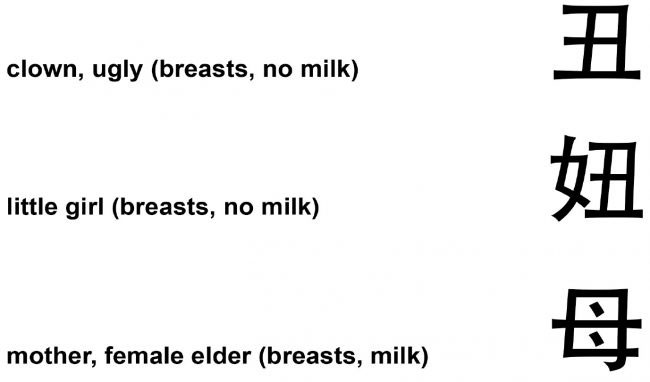
Figure 18. Historically, a clown is a man in women’s clothing. That is an underpinning of comedy. The two boxes in the word for “clown” represent breasts, but there are no dots, so they are not functioning breasts. “Little girl,” a character composed of “female” to the left and “clown” to the right, also has no dots in her two respective boxes because she, too, has no milk. “Mother” has two dots in her two boxes, signifying functioning breasts, which means she has milk. Structural analysis is key to decoding Chinese.“Mother” has milk, so she has two dots in her two respective boxes which signify for breasts; the little girl does not yet have milk, so the character that depicts her has two boxes and no dots (Figure 18). “Little girl” is a combination of “female” and “clown”—丑. A clown is a man in women’s clothing (a BFA in Theater Arts from UCLA informs this opinion), therefore he is depicted with two boxes, no dots. This could also inform the meaning of “ugly”: breasts but no milk. Written language is constructed in the brutal mindset of an inequitable past. Two Hanzi characters make this abundantly clear, and both contain nü3 女 and tian2 田—but the orientation of the two makes all the difference in meaning (Figure 19).
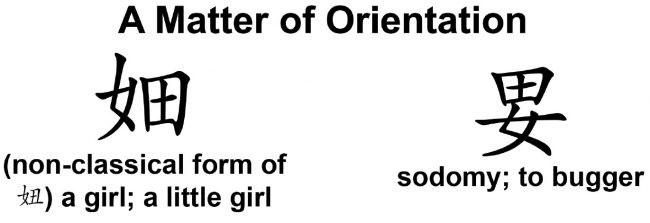
Figure 19. The field substructure in the right character implies that it is a target, as it did in the word for “prostitute” miao2 㑤. Could the field character be a bull’s eye that says, “+ marks the spot for fertilization?” This tian2 田 character is also found in a character that means “hunt”: tian2 畋.The first example is female left of field = little girl. The second example is female under field = sodomy. Odd that just changing their positions yields such different meanings, yet it makes sense if one goes back in time to when little girls were not as protected as they are now. That field character tian2 田 is a bull’s eye of sorts. Even little girls are potential targets because they will eventually be able to reproduce, and with the right lineage and circumstance, they could be valuable. Language is all about control and domination, as is much of human nature.
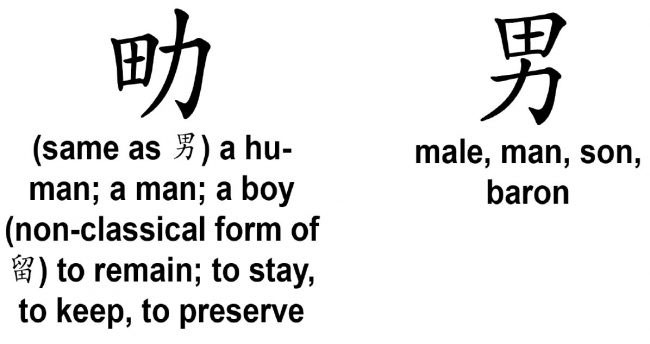
Figure 20. Here is a similar scenario as in Figure 19, yet the definitions are more predictable. “Field” plus “strength, power” yields “male” in both orientations, unlike above where “female” plus “field” had very different meanings depending upon orientation. (“Power” 力 is really a “knife” 刀 with an aspect line, and is probably, at its root, a “penis,” the ultimate expression of power: to procreate).A parallel example (Figure 20) examining the word for “male, man, son, baron”: 男 and “a human; a man; a boy (non-classical form of 留) to remain; to stay, to keep, to preserve”: 㽖 demonstrates that changing the orientation for this male word does not change the meaning. Keeping in mind that men wrote language while women were busy (dying in childbirth, weak during pregnancy, raising children), the inconsistency in these two examples is rooted in the perspective that ancient men had, which viewed females as tools for use.
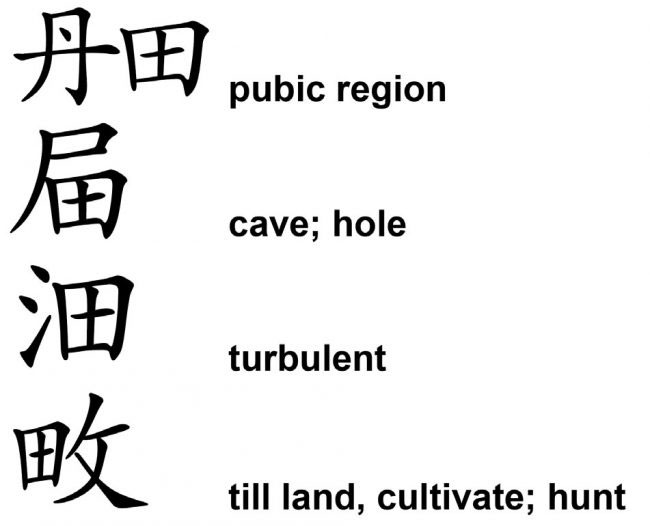
Figure 21. Four examples that include the “field” radical demonstrate that the tian2 田 radical is metaphorical and includes a broad interpretation of “field.” At top, “pubic region” is consistent with “vagina,” as is “cave; hole.” “Turbulent” could describe conquest (“water” is often a euphemism for “semen”), and the final example, “till land, cultivate, hunt” is consistent with predatory behavior.Searching Chinese textual databases uncovered these above characters, all of which include the field radical tian2 田. The top example (Figure 21), “pubic region,” consists of “vermilion” or “cinnabar” on the left (think “red”) and “field” on the right. A pubic region—dan1 丹 tian2 田—is a “red field.” The next example is the shi1 尸 “corpse/body” radical plus “field,” which means “cave or hole” tian2 屇 Though modern day humans may have a hard time equating a body with a cave or hole, in order to understand any language, one must step out of one’s default understanding and enter the mentality of the culture one wants to embrace. “Turbulent” tian2 沺 could describe conquest (“three drops water” radical plus “field”), and “till land, cultivate, hunt” tian2 畋 is consistent with predatory behavior.
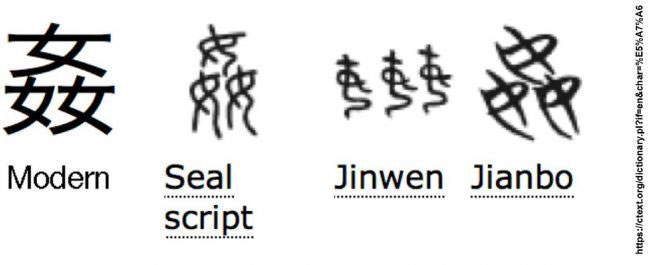
Figure 22. The character for “adultery” has included three women for 4000 years.To understand Chinese, or any written language, one must go back mentally—5,000 – 10,000—years to when written language began. Examining triple radicals is one way to do this. If one radical means X, then tripling the radical should mean 3X. For example, three trees is a forest, three men is a crowd, three horses is a herd, and three water signs is a flood. All these are very logical. However, three women is adultery. And it appears to have meant this for 4,000 years (Figure 22).
This seems aberrant to us—but it isn’t to men who don’t have the advantage of DNA tests to tell them if they are really the father, or modern relationships where consent is mutual and brides are not bartered or imprisoned. These characters, along with their definitions, are archaeological relics. They tell us about the culture when these characters were first inscribed. This was a culture that viewed women as something to be owned, a culture that gave no importance to a woman’s feelings of attachment or even her mobility. Keep in mind that the production of tiny shoes for bound-foot women ended in China in 1998 (SFMuseum, 1998).8 But the current inequity in reproductive rights in the US shows a similar anachronistic ethos.
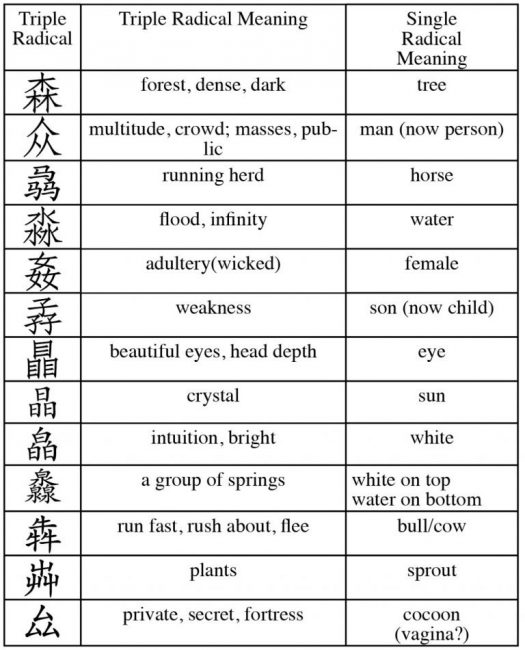
Figure 23. A small sampling of triple radicals.The precursors to the character for adultery jian1 姦 (Figure 22) are, moving from left to right, Seal Script from the Bronze Age; Jinwen, circa 1100-770 BC; and Jianbo, an ancient form of writing on silk (for a sampling of Triple Radicals, view Figure 23; for a full Triple Radical database, go here: https://originofalphabet.com/chinese-triple-radicals-2/). In all four depictions, a trio of women are a consistent representation of evil. If one woman is bad, three are plotting. In a repressed society, women’s only outlet was gossip, and scandal was the soap opera of the day. A group of women clustered together would be suspect, especially when male control was absolute. Adultery would have been a serious transgression—and something to whisper about—because unlicensed sex could produce a future of competing genetic lineages. Illegitimate children were a threat to those in power. Putting structures in place to retain power is part of why writing started.
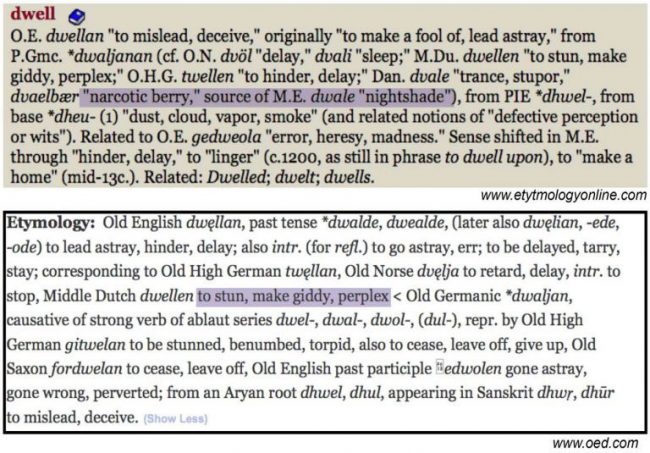
Figure 24. The roots of “dwell” include deadly nightshade (see purple highlight above), according to www.etymologyonline.com. OED (below) does not include nightshade as a root, but it does include “stun, make giddy.” Some cultures bound feet, some used drugs, and some used other types of restraints in order to control humans.
Ten thousand years ago, the first stage of writing was in the form of tokens, which were used as a way to keep track of slaves, livestock, and other commodities. When women are commodities, impregnating them is a crime. Unsanctioned procreation means that male A’s seed is growing in a woman owned by male B, which would be a breach of ownership. The only way a man could attempt to ensure he was the father before DNA testing was to know where his women were at all times. Crippling a woman by binding her feet, as people did in China for more than 1000 years, was one way of ensuring that one’s woman wouldn’t be inseminated by another because her mobility would be restricted, limiting her access to other men. China is not the only culture that controlled women however. Other cultures appear to have used different techniques to subdue humans, including drugs (Figure 24). Deadly Nightshade, also known as Belladonna—“beautiful lady” in Italian—is at the root of the word “dwell,” according to http://www.etymologyonline.com. Ancient Egyptians had depictions of tethers and prisoners in bondage in many of their words, however, the tethers had been replaced by the “loaf” shape (a seeming “breast” depiction) by the time of the Middle Kingdom. Western culture had corsets.
4. Metaphor: Rice Is Seed; Woman Is a Field; Seed Is Semen

Figure 25. Rice is so important, it has more than one depiction. Here are two different radicals that mean “rice.”Owning and controlling land, seed, and women are the recurrent themes of language. These possessions are metaphorically interchangeable, such that a woman is a field, and sperm is seed. When a character is used metaphorically, the character becomes a common component of other words. Seed is metaphorically depicted as rice in Chinese script. The importance of grain in fostering the beginning of civilization is touted in Guns, Germs, and Steel, but the picture of grain itself is revered in the Chinese language. Two different radicals represent different aspects of rice, the major grain of China (Figure 25). The radical that is “hulled or husked uncooked rice” is pronounced emphatically—think DeNiro in Taxi Driver: “You talkin’ to me?” That “me” is how to pronoun “rice” in Chinese. However the tone of mi changes to a more playful sound when calling a cat. The cat-calling mi1 咪 uses the first tone in Chinese, and this tone sounds like the third note in the Sound of Music’s famous “Do, Re, Mi” song, spelled the same way as the pinyin. According to OED, the musical note “mi” comes from “mira,” which means “miracle” in Latin. “Mira” means “look” in Spanish. “Mirage” is related. A mirage is something that is difficult to see, and the character mi3 米 is all about squinting because of brightness. (The character mi4 日 can also mean “sun” [Chinese Text Project, 2019.]9) Being dazzled is a theme which carries through many “mi” words. The shape of the character mi3 米 resembles a flash of light, the glint of reflection off water. It resembles the sun in its roundness. The bilaterally symmetrical mi3 米 (Figure 26) resembles a snowflake, as you can see in variety of typefaces (Figure 27). Snow is known for its whiteness; mi3 米, too, represents whiteness by implication.
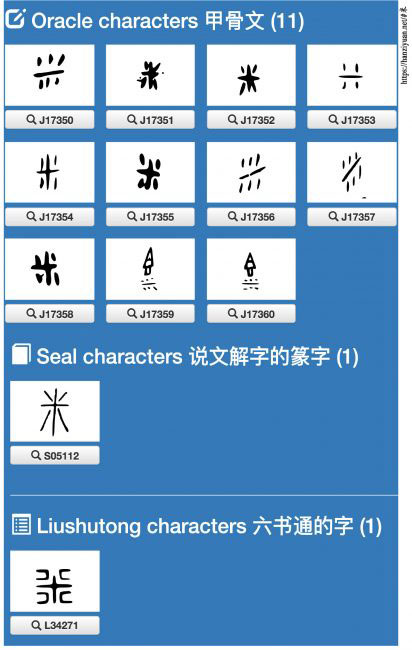
Figure 26. Mi3 米 through the centuries—always nearly bilaterally symmetrical.

Figure 27. A whole lot of rice—seven (type) faces of mi.If one considers all the things that rice is: 1) seed; 2) white; 3) sustenance; 4) sticky; 5) ubiquitous; and 6) identical to other grains, it makes logical sense that this mi3 米 character is a component of many disparate yet related characters, such as “phosphorous”—lin2燐—because white things glow. This is the same reason that mi3 米 is in “air, gas, steam, vapor; spirit”—qi1 氣—because vapor is white. When there’s a lot of mist, it’s hard to see and one may feel “confusion”—mi2 迷 or perhaps instead enjoy the sensation as the same character mi2 迷 also means “bewitch, charm, infatuate.” When one is dazzled by whiteness—or a lot of rice—one may be intoxicated.
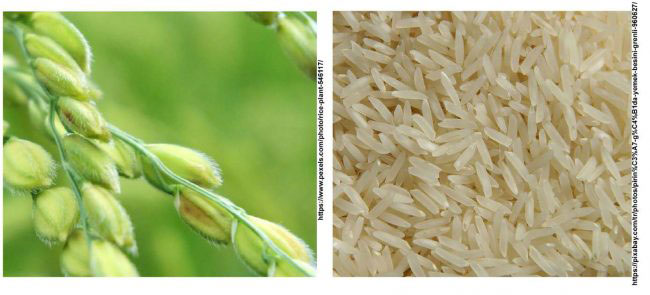
Figure 28. Rice, seen here as “grain still on the stalk”— he2 禾—as well as husked and ready to be cooked—mi3 米.

Figure 29. The Chinese sound for calling a cat is “Me.”
Food is an intoxicant when one is starving. Eating wasn’t as habitual as it is now. Hunger was a frequent condition in the beginning of man. When one’s entire life is focused on survival, food takes on more meanings; mi3 米 is rice, but it is also seed, the progenitor of rice (Figure 28). When characters are honed over thousands of years, they tend to pick up meanings as they get molded into perfection. Rice is a grain; a grain is a seed; a seed multiplies and reproduces. Reproduction matters to early man, so this seed is equated with something else that reproduces rapidly: cats. This white-inflected, round, food representative is also the sound a cat makes, and consequently, the sound to call a cat (Figure 29), which is mi1 咪. The shape of the character mi3 米 even resembles a cat’s face, and that “me” sound is the beginning of the word “miao/meow.” A mink, a cat-like animal whose name begins with “mi,” has similar associations to women as does a cat; according to OED, “mink” is “U.S. slang, an attractive or sexually provocative woman; a girlfriend, also in extended use. Cf. fox…minx.” Not surprisingly, two of these “sound to call a cat” mi1 咪 characters said together mean “tits,” 咪咪 (mi1 mi1). Could the shape of 米 imply one breast? 米米 two? The areola the point of intersection? Breasts do have an association with whiteness.

Figure 30. The Chinese character for “rice” and measure word for “meter.”Mi3 米 is also a measure word for distance, a unit of measurement, a representative of the smallest unit (Figure 30). Could “million” or the Latin word mille meaning “thousand” be related? OED says “of unknown origin.”
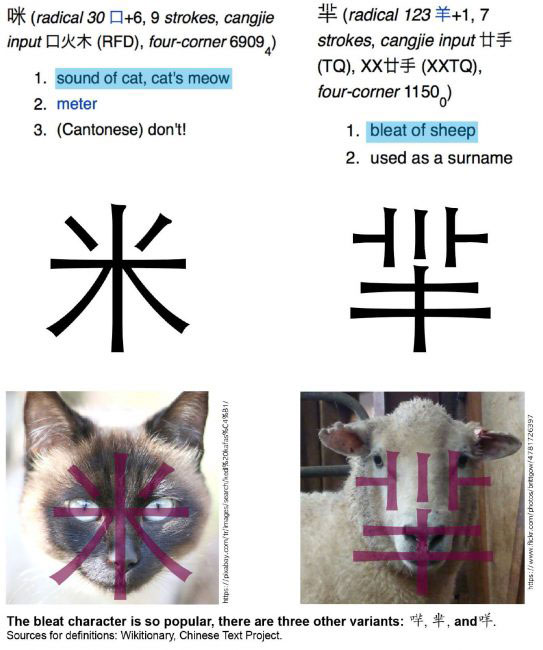
Figure 31. Cats vs. sheep.The similarity between the character for calling a cat, and a cat’s face (frontal view) is seen by superimposing one over the other (Figure 31). There is also a character which represents the bleat of a sheep (also pronounced mi3), and it too resembles a sheep’s face from the front. Depicting an animal’s head frontally is a reverent act—it gives the animal face, literally, in a culture that constantly thinks about preserving and losing face. Cats, it would seem sheep, were special creatures to early man, and so they earned a character that presented them as more than just their bodies. They were so special, they were depicted with faces.
Mi means “face” and “food.” In both languages, English and Chinese, mien/mian 面 means “face.” In English, “me” is our identity, yet it could also be “meat” with just the addition of a “t” sound. Humans are meat, much as we hate to recognize it; and “meal,” besides being a time of eating, is also the “edible part of a grain” (OED).
Rice allowed the Chinese culture to flourish; mi3 米 means rice, yet the character looks more like a face that is reacting to the blinding whiteness of rice; the “eyes” in the “face” are tilted and closed, seemingly in order to shield them from the brilliance; mi1 瞇 means “squint”; mi3 眯—which is “eye” plus “rice”—means to be “blind.” A depiction of an “eye” in a character usually means “to see,” so by process of elimination, this implies that the rice character conveys the meaning of “obstruction.” “Myopia” is the condition of bad eyes. According to OED, “myopia” is related to “mystery,” which has “the base of μύειν to close (the lips or eyes), probably of imitative origin.” When we close our lips and hum, we make the mmm sound. Babies close their lips to take in food; if they don’t have enough food, they start making noises that sound like mmm as their lips try to take in food. “Mmm” is synonymous with hunger. “Mmm… mama” is the sound that says, “Feed me!”
Clearly mi3 米 signifies for ideas that are even more expansive than just narrowing the eyes and calling cats. Representing grain, this character is found in many words that play on the metaphorical idea of rice as a seed—something which starts small but grows to abundance. When a concept is important—and the concept of food was huge in the beginning of humans—the character which stands for that concept ends up being used in many related words. The original idea is an underpinning to subsequent ideas. However the original idea wasn’t just an idea, it was food. Sustenance is key when it comes to having the energy to extrapolate. When you’re starving, you don’t have time to invent written language. Once you have abundance, controlling it, taxing it, and doling it out necessitates record keeping. A prevailing theory suggests writing started as accounting. Rice isn’t significant in ones. You need thousands of kernels for even a bowl. Once humans figured out that this small grain could feed a multitude, rice took on huge stature.
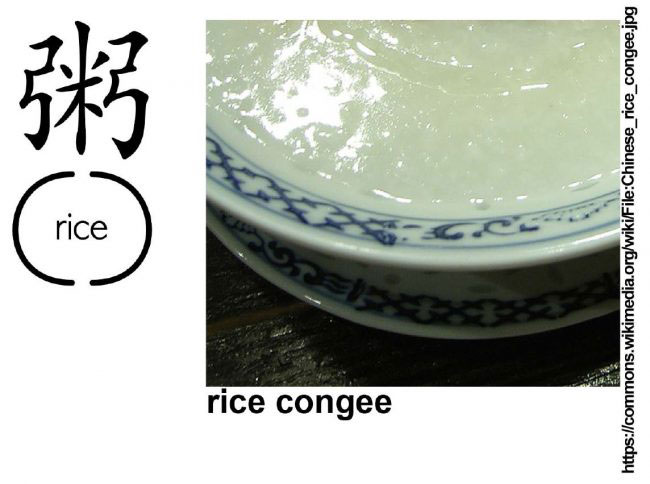
Figure 32. This character is a conceptual bowl of rice. The two flanking characters represent bows: two bows make a bowl, with rice in the center.The character mi3 米 is in words that include “paste,” “glutinous,” and “mucous.” If you’re wondering why, look at a bowl of rice congee (Figure 32). The word “congee” describes a gelatinous porridge of rice. If rice gruel was a staple, you would expect to find it in many words, and you do. Perhaps even in our words as well. Could “congeal”—“with gel”— be a form of “congee?” The character for congee is two bows and rice in between. A bow is a half circle. Two half circles make a circle. A circle can describe a bowl (see “bow” in the word “bowl?”). This character—粥—represents a bowl of rice.
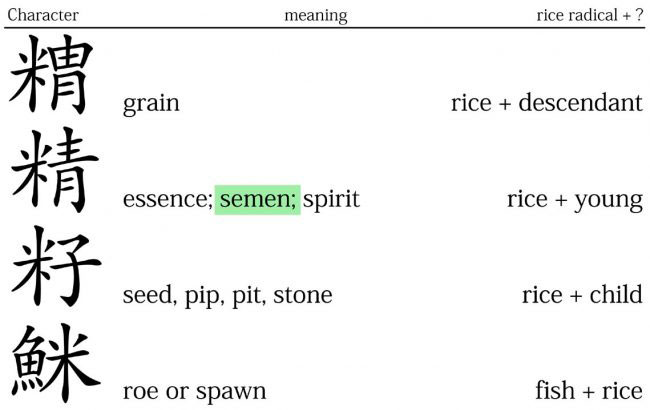
Figure 33. Rice plus another character means “pre-baby,” so rice represents “seed.”The table (Figure 33) shows rice plus other characters found in definitions related to reproduction. The first example, “grain,” shows the rice radical combined with “descendant.” The concept of grain is that it is the descendent of seed. Rice was more than rice to the ancient Chinese. Rice was the future. Rice was posterity. Being a metaphorical culture—like all literate cultures—the fact that rice congee looks a lot like semen is not lost upon the ancient Chinese because this rice character is also the radical for “essence, semen, spirit” jing1 精 (see green highlight). This character which means “semen” is composed of “rice” on the left, conceivably the radical meaning “seed,” and a character on the right which many people think means “blue,” but in actuality means “essence, purity, and youth,” which all have resonance with the concept of “semen.” The idea that after a man ejaculates, he is now “purified” is also seen in the Japanese word “kenjataimu” which means “post-coital clarity, period after orgasm when a man is free from sexual desire and can think clearly” (JLearn.net, 2018).10
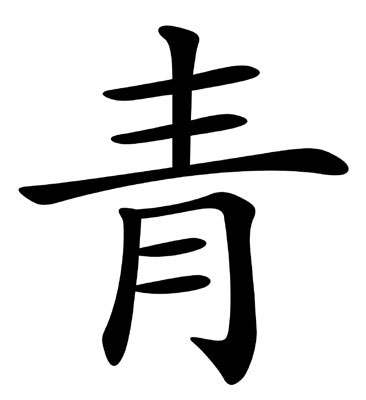
Figure 34. Qing1 is not just blue. Could it literally depict “flesh exploding?”On the right side of the character for “semen” is qing1 青 (Figure 34) which has many color meanings beyond “blue,” including “black,” “green,” “red,” and “clear,” and then meanings related to “greenness,” both literal and metaphorical: “luxuriant; lush; exuberant; young; adolescent; east; spring; ripening crop” and more (Ball & Chao, 2018),11 but these are perceived as the essence of an entity. This character qing1 青 appears to be about “flesh exploding,” which is a literal description of “ejaculation.” Semen is shot out of the penis during climax. This qing1 青 depicts the act. This character is all about the ability of young men to ejaculate easily and “sow wild oats” exuberantly, which produce offspring.
The third example of the Table at Figure 33 shows rice combined with a child character which produces the meaning “seed, pip, pit, stone.” In all of these words, the rice radical is telling the reader to think in the “seed/egg/grain” category. The rest of the Hanzi character gives the specifics once you’re in that “egg” mindset. Even in the case of “roe, spawn,” where fish is the radical, the addition of rice doesn’t mean a satisfying meal, instead it means “caviar,” which is a tasty fish dish, but the rice character here doesn’t signify for “rice” as much as it does “seed.”

Figure 35. Rice can stand-in for reproduction.If mi3 米 and its variation he2 禾 is conceptually more seed than rice, and miao2 苗 means to make a copy of something, it is no surprise that together they mean to reproduce (Figure 35). The rice radical (in its bian4 釆 superstructure, meaning “distinguish”) sandwiched between the two halves of miao2 苗 accentuates the fact that life is flourishing. The example below, “a fetus inside the belly,” shows rice inside a box, theoretically “a belly,” and the radical on the left is the flesh radical. One note about the flesh radical: it almost always looks like the moon, though its “official” depiction looks more like a suggestion of ribs and a spine enclosed in a body (Figure 36). If you consider that the best eating on an animal is the rump, and that “mooning” someone (in the West) is to show your rump, a relationship can be seen between moon and flesh: the whitest part of the body is the part one keeps covered.
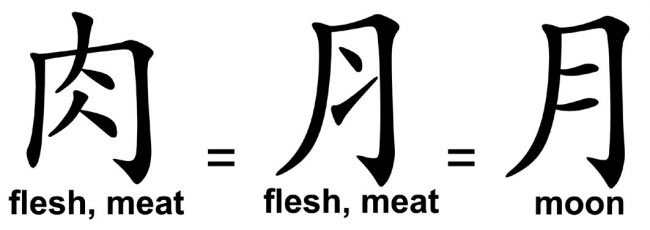
Figure 36. The “moon” radical is often used for the “flesh” radical in Chinese. This is both a simplification—note the similarities in orientation and horizontal “stripes”—and a kindness: The moon is easier on the eyes and conscience than seeing an actual backbone, which is what the leftmost character depicts.Figure 37. Qing1 means “restroom, pigsty.”
The disturbing nature of this theory—that humans are animals and have acted like animals in the past—is what keeps people from making these connections. We live in denial and euphemism. The swapping of actual meat—that looks uncomfortably upright and human—for the moon is an example of this euphemistic process. To include a graphic representation of meat is too painful for humans, so we—if we learn Chinese—swap the “meat” radical for the “moon” radical. Edward Albee pointed out the human fear of bodily functions in Who’s Afraid of Virginia Woolf when George calls the bathroom a “euphemism.” Now even “bathroom” is too personal, and we have substituted the word “restroom.” In Chinese, 洗手间 the politest expression for the toilet, means “wash hands room,” yet the predominant use of this room (or hole) is where we defecate and micturate—poop and pee. An archaic word for “restroom” (and “pigsty”) in Chinese is qing1 圊 (Figure 37), which is really “purity in a box.” The irony is that we’re pure after the event, but the event itself is not pure, no matter how much we fixate on the cleanup.
5. “Cat” Is What You Say If You Do Not Revere the 猫
Clean up is something cats do well. They are known for fastidiousness. Cats are also known for kittens; however, rapid replication makes an entity less special. As civilization progressed, so did the cat population. Every town I have visited around the world has cats. If a civilization sees worth in cats, the name of the animal is more likely to be onomatopoeic: meow. However, if a civilization views cats as unconstrained breeding machines, it calls them by the less reverential, monosyllabic “cat.” This is more evident in Western languages.
“Cat” signifies for one of many, just as “rice” does, and as “woman” did back when women were cloistered in some type of safe enclosure. Barns and harems share commonalities: One stud male, many females; a barn bars exit. Female mammals are valuable. You don’t want just anyone stealing them or attempting to impregnate them. But some men were unstoppable. Genghis Khan allegedly impregnated myriad women. That means a lot of us are related to Mr. Khan. Sixteen million direct Khan descendants are currently living today. Khan did not ask those women for consent. Consent is a new idea.
According to a paper entitled “The Genetic Legacy of the Mongols,” researchers claim, “We have identified a Y-chromosomal lineage with several unusual features. It was found in 16 populations throughout a large region of Asia, stretching from the Pacific to the Caspian Sea, and was present at high frequency: ~8% of the men in this region carry it, and it thus makes up ~0.5% of the world total. The pattern of variation within the lineage suggested that it originated in Mongolia ~1000 years ago. Such a rapid spread cannot have occurred by chance; it must have been a result of selection. The lineage is carried by likely male-line descendants of Genghis Khan, and we therefore propose that it has spread by a novel form of social selection resulting from their behavior” (Zerjal et al., 2003).12Found on MIT’s RaceScience website is an explanation for this form of social selection: “The paternal counterpart is the Y chromosome. Women, of course, lack the Y chromosome, so it is inherited strictly from father to son. It can be quite revealing to trace how the Y chromosome and mitochondrial DNA mix in a single population. Under the old South African apartheid categories, “colored” people were those who descended from black and white parents—but their Y chromosome almost always shows a European ancestry, whereas their mitochondrial DNA usually shows an African heritage. To put it plainly, white men were sleeping with black women, but black men were not sleeping with white women.
“This pattern is common wherever one finds ‘dominant and subservient groups’, says South African researcher Himla Soodyall. In southern Colorado, for example, a group of Hispanics trace their ancestry to Spanish settlers from the 1500s, before Jamestown. ‘Their oral history says they didn’t mix with the native Americans’, says University of Michigan researcher Andrew Merriwether, who studied this group. But genetics tells a different tale: about 85 percent of them carry mitochondrial DNA of Native American origin. Other genetic markers show a strong European heritage, which indicates ‘directional mating’, says Merriwether. As in South Africa, European men were sleeping with Amerindian women, but Amerindian men were rarely sleeping with European women. Partly this is because few Spanish women traveled with the conquistadores, but it’s also due to sexual politics, and they are inscribed on DNA” (Schoofs, 1997).13
If all this makes you feel squeamish, it should. Yet it’s hard to fault those conquering ancestors because we exist, and we are their progeny. Consider that you have perhaps procreated yourself. You beat out other competitors by breeding. It’s all a matter of perspective. A cat-and-mouse game is only a game to the cat. The mouse doesn’t live to tell its agony. Expressions and clichés reflect a conqueror’s perspective because these characters are relics: proverbial bones from the languages of the survivors. Every culture’s dictionary is an archaeological dig. The past is speaking to us every time we decode a sentence or character. And that past was viewed by the eyes of the victor.
In Chinese, the definition “Cutting off feet as form of punishment” (Figure 38) has only a knife on the right and flesh on the left (euphemistically depicted by the moon). How would one know which flesh was to be cut? Was cutting off the feet the most common flesh to be removed? Does the fact that women were hobbled for more than a millennium suggest that this character may not have needed more clarity? The simplicity of this character—yue4 刖—suggests it was used regularly. If these types of punishments were readily administered, human beings were significantly less special than they are now. And if humans were less special, imagine how cats were treated.
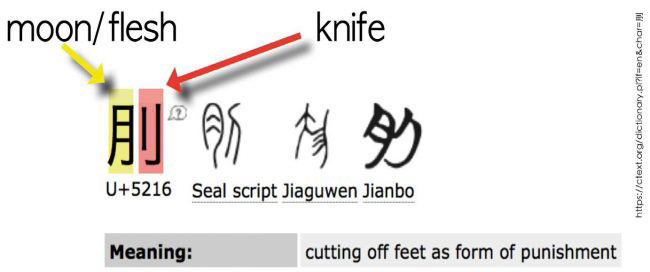
Figure 38. The simplicity of this character is striking: flesh + knife = no feet.There is no word that specifically means “cat” in Strong’s Concordance, which is a lexicon of words from the Old and New Testament. However, in the global search for sounds related to “cat,” there is the word “qt,” קט in Hebrew (the language is read right to left, so our rendition is a mirror image of theirs)—pronounced kat according to the International Phonetic Alphabet (or IPA)—which means “small thing” (Figure 39). This sound—which I would spell “cot” after listening to the voice at https://www.blueletterbible.org, one of the websites that has Strong’s Concordance—signified “small” in many early cultures. Even now, our word “cot” means “small bed”; “cottage” means “small house”; “cotton” is a small ball of white plant material; and “cut” means to make something smaller. The seeming unimportance of this monosyllabic word that means “smallness” is balanced by the longitude of its sound/meaning correspondence: kat/kot/cut has meant “small” for several thousand years.
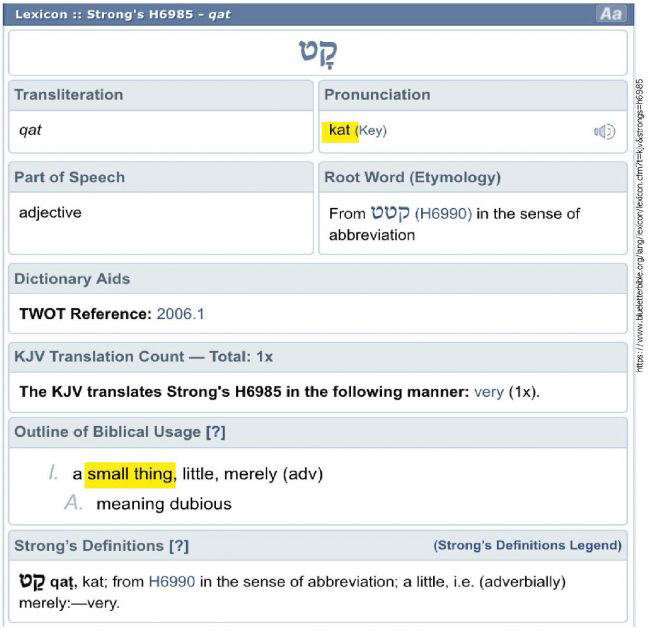
Figure 39. “Qat” in Hebrew pronounced “kat” means “small thing.”When an idea has a sound correspondence for that long it suggests that human populations find something logical in that association. That sound-to-meaning relationship has stuck with us for a reason. The Ancient Egyptian word for “to be little,” “little girl,” and “louse” was “ktt” (Figure 40). Hebrew’s “qtt”—טטק—means “to be cut off” (Figure 41). Something cut off something else would be, by definition, little, because it would have been clipped from the main entity. This description fits even the sense of “louse,” which is a little insect that sticks to the body until you pick it off.
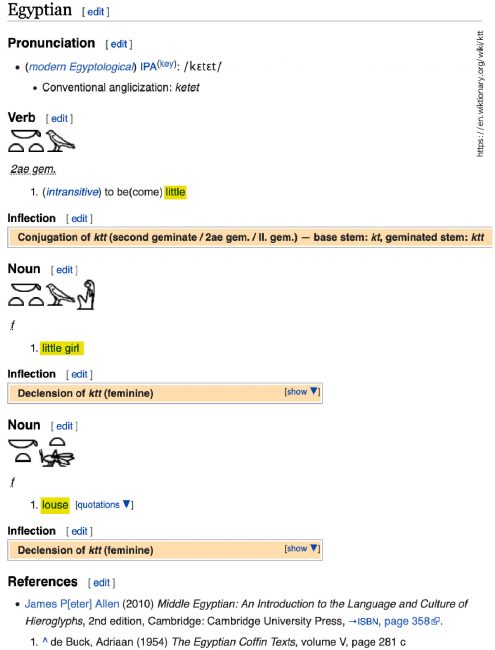
Figure 40. The Ancient Egyptian hieroglyph “ktt” means “little.” The sound kat/ktt has represented “smallness” for thousands of years, and smallness suggests “cats” and “fe- males.” “Kitty,” “Kitten,” “Kate,” “Katie,” “Cathy/Kathy,” “Cathleen/Kathleen,” and “Caddie” are all common names for female humans.
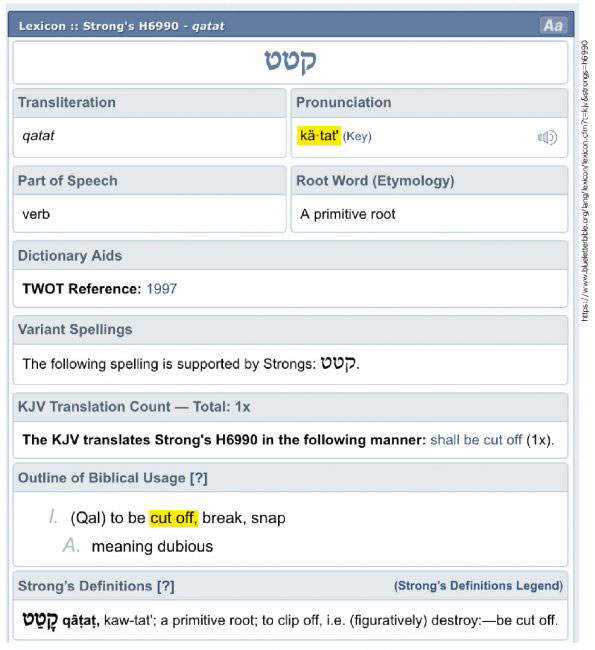
Figure 41. “Qatat” in Hebrew pronounced “katat” means “cut off.”The sound of t often swaps with d. This is because the tongue is in exactly the same place in the mouth to form both sounds. The only difference is one is voiced—/d/—and one is not—/t/. “Voiced” means that one is using one’s larynx. If you put your finger on your Adam’s Apple while you make the /d/ sound, you can feel it move. This does not happen when one makes a /t/ sound. But the tongue and mouth are in the same positions, so the sounds are very close. In Sumerian the word for “cut” was pronounced kud, and this has been attested for 1111 times (Figure 42). To English speakers, “cud” is the small mouthful cows chew when they cut the grass with their teeth. Similar in sound, a “kid” is a young child or goat: offspring that are “cut off” from the mother; “kitty” is a small cat. These words have a relationship to each other if one thinks in terms of basic concepts and also if one thinks in terms of sex.
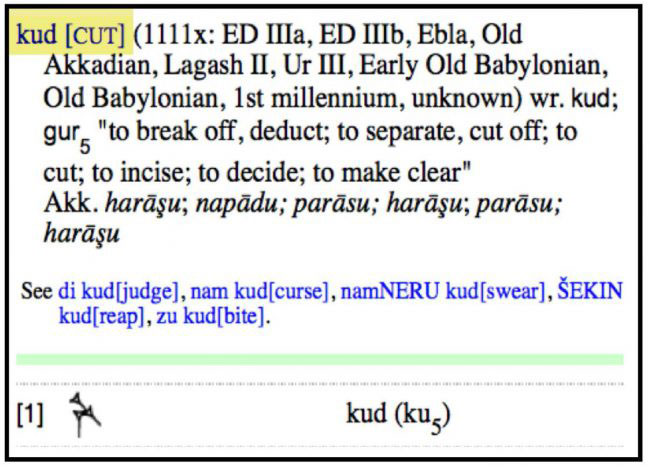
Figure 42. In Sumerian, the most common word (1111 times) for “cut” is kud, according to the Pennsylvania Sumerian Dictionary which is maintained by the Babylonian Section of the University of Pennsylvania Museum of Anthropology and Archaeology at http://psd.museum.upenn.edu.In Sumerian, kita meant “lower” (Figure 43) which is where down is, and where one finds cats, children, and women, because they are all statistically smaller than men. In Ancient Greek, the closest “cat” word—kata—means “down” but kata is rarely written by itself; usually it is compounded with another word. The Greek word καταβολή (Figure 44) shares the sense of fertility with miao, with the strongest sense being “the injection or depositing of the virile semen in the womb,” but it also means “laying down a foundation” (Bible Study Tools, 2019)14, which is what progeny do. This “kata” idea—whether sprout, feline, or child—seems rooted in the idea that something small will get bigger and reproduce. In Japanese, kata means “pattern, model, type.” Its literal translation is “shape which cuts the ground” (The Martial Way, 2019)”15 or “pattern in the earth” (The American Karate and Tae Kwan Do Organization, 2008).16 This is a lot like the phrase, “to leave one’s mark,” which is what one does when one reproduces.

Figure 43. In Ancient Egyptian “kita” means “lower.” Things that are small tend to be lower.
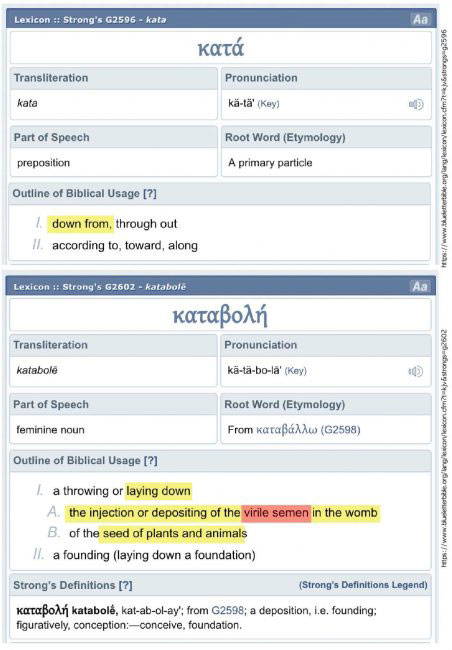
Figure 44. In Greek, “kata” means “down from.” The Greek word “katabole” means “to deposit semen.” We can see the relationship to “catabolism” with the release of energy, something exploding.“Cat” and “miao” seem inextricably linked. In Ancient Egyptian, myw meant “semen” (Figure 45). If you recall from page 1, miw meant “cat” (pronounced myw—identical to “semen”). The relationship between cats and fertility that is seen in Western culture (e.g., sexy models strut on a “catwalk” displaying the latest hot fashion) is also seen in Chinese—not only in the word for “pretty girl” mao2 媌, mao3㚹, and miao2㑤—(the last example also carries the meaning of “prostitute”), but also in the word “tits” 咪咪 (mi1mi1). This same conflation of cats, women, and fertility appears to have existed in Ancient Egypt as well. A list of words from Ancient Egyptian that started with the sound mi—the first half of “cat”—shows a similarity of meanings related to seed and replication (Figure 46). The sound “me” has a universal theme of cloning (think “meme”).

Figure 45. Dictionary of middle Egyptian in Gardiner classification order, Paul Dickson, December 1, 2006.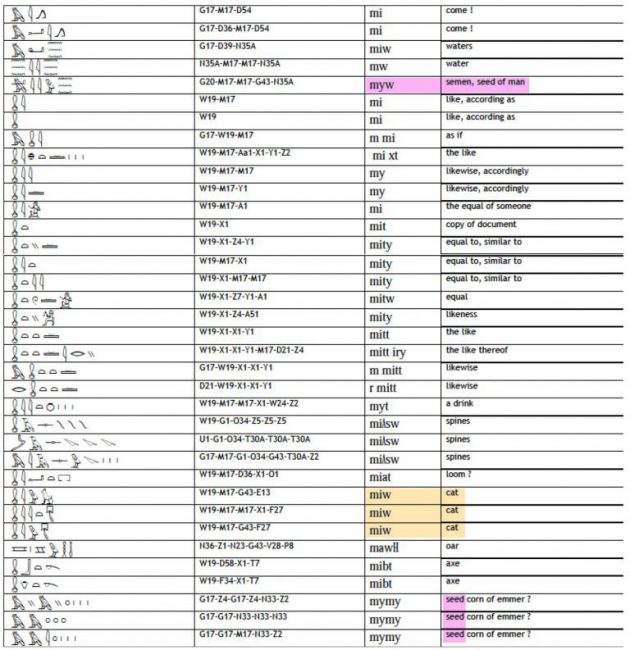
Figure 46. A list of words in Ancient Egyptian that begin with “mi” from https://pt.scribd.com/doc/10929802/Dictionary-of-Middle-Egyptian. Besides meaning “cat” (see bottom), these words center around making copies and semen (including the euphemistic word “waters”). Even “spine” could be a metaphor for an object which injects. The preponderance of words that signify for equivalency also shares the letter “T,” which was the feminine ending.Isidore of Seville (7th century AD) writes—his actual words are in italics—“The offspring of any kind of animal are incorrectly called “pups” (catulus), for, strictly speaking, pups are the offsprings of dogs” (Barney et al, 2006).17 He also writes, “The mouser (musio) is so called because it is troublesome to mice (mus). Common people call it the cat (cattus) from ‘catching’ (captura)… Others say it is so named because cattat, that is, ‘it sees’—for it can see so keenly (acute) that with the gleam of its eyes it overcomes the darkness of night” (Barney et al., 2006).
The predatory nature of cats, along with their good eyesight, makes them human’s doppelganger. Cats, eyes, and women were often synonymous in early history, especially in Ancient Egypt. In Mistress of the House, Mistress of Heaven, Women in Ancient Egypt, the authors write, “A variety of feline goddesses were also popularly represented in amuletic form. One of the oldest to appear is the goddess Bastet, patroness of the city of Bubastis in the Nile delta. As an amulet, she typically appears in late Dynastic Egypt as a seated cat, often accompanied by her kittens… cat amulets were almost certainly worn by women for their fertility-enhancing powers. Along with a number of other female deities, Bastet was often represented as a maned lion-goddess” (Capel & Markoe, 1996).18
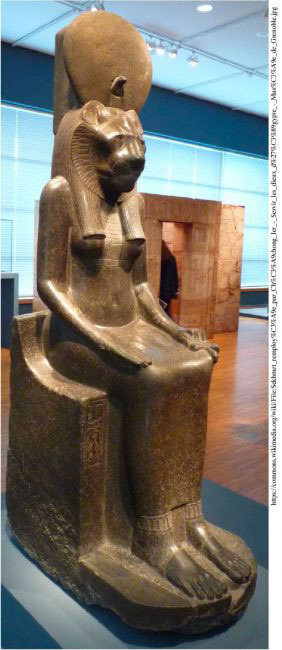
Figure 47. The busty Ancient Egyptian lion goddess Sekhmet is one form of the Eye of Ra; the Eye is the consort and the daughter of the sun god.
According to Geraldine Pinch, an Egyptologist at the Oriental Institute of Oxford University, “The images of lions and cats tearing out the throats of foreign captives may allude to the myth of the Eye of Ra being sent down in her lion form (Sekhmet) to destroy the humans who had rebelled against the sun god… When the eye who was the first-born daughter of Ra [the sun god] became alienated from her father, she wandered the deserts [as a Distant Goddess] in the form of a lion or a cat… A relief in the temple of el-Dakka in Nubia showed this goddess with the full mane of a lion and the swollen teats of a nursing lioness… The myth of Thoth and Shu luring the Distant Goddess back to Egypt with promises of food and comfort mirrors the way the Egyptians had transformed wild cats into pets… An Instruction Text of the Greco-Roman Period warns Egyptian men that women are like a friendly cat when you give them what they want and like a raging lioness when you cannot” (Pinch, 2002)19 (Figure 47).
Women are likened to many animals, but felines have the most constant association because they seem like “feminine” animals. The word “pussy” stands for both cats and female genitalia: most likely because they are both soft and strokable. OED writes that “pussy” means a girl who is cat-like: “Chiefly colloq. A girl or woman exhibiting characteristics associated with a cat, esp. sweetness or amiability. Freq. used as a pet name or as a term of endearment.”
In Sumerian, the concept of “cat” was represented by three different sets of cuneiform, and the pronunciations were sua (71 times), suari (two times), and gullum (one time). Breaking these words down to their component parts demonstrates that the Sumerians did not revere cats; cats’ only value were the parts of the cat which the Sumerians could use.
Think of the first example, sua (Figure 48) as an addition problem: su catgut + a progeny = sua cat.
The word gullum (Figure 49) is composed of:
gulla destroy + lum fertile = gullum cat.
Gullum is only attested one time, but it looks like a cat from an aerial view. A clever synthesis that utilizes a similar breakdown of meaning (“parts useful when killed” + “fertile”), “gullum” satisfies both the conceptual meaning and the physical depiction of a cat. A related word, kigula, meant “destitute person.” According to John Halloran, who maintains a Sumerian lexicon, gullum means “cat (‘to fall upon, destroy, extinguish’ + ‘fertile’; cf., ki-gul-la) (Halloran, 2018).”20The related word, “ki-gul-la: waif (‘ground’ + ‘to fall upon’ + nominative; cf., gul-lum),” suggests that cats and waifs were equal. A waif, says OED, is “a piece of property which is found ownerless and which, if unclaimed within a fixed period after due notice given, falls to the lord of the manor; e.g. an article washed up on the seashore, an animal that has strayed.”
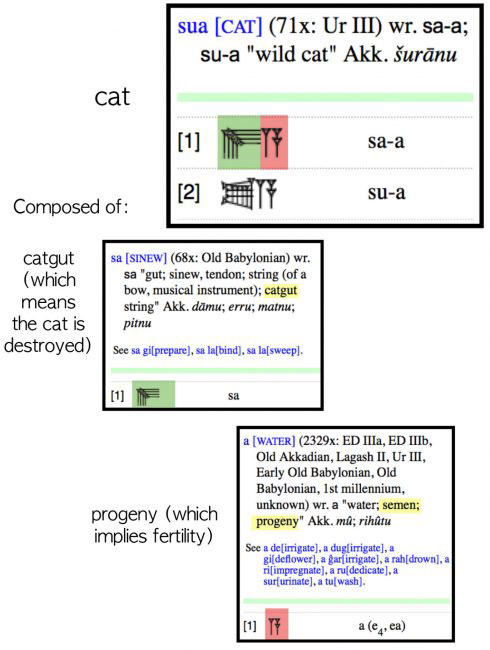
Figure 48. The Sumerians saw cats as tools to be used for their sinew, and they saw cats as fertile.
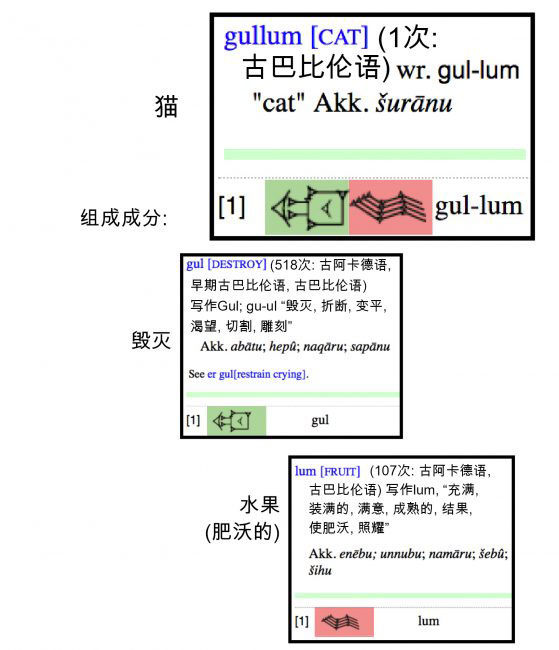
Figure 49. Though the depiction and sound are different for these two Sumerian words which mean “cat,” the concept is the same: cats have an association with destruction, and they are fertile.
“Waif” and “wife” both fall under the control of the head of the house. Women have been considered pieces of property for a long time; unattached women are not unlike stray cats to opportunists: available for use. However, a stray to one is a pet to the next. Taming wild animals is the lure of both cats and women, and humans like conquest.
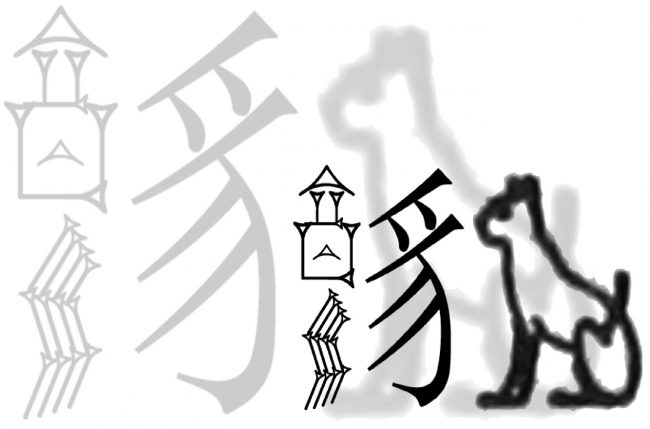
Figure 50. Three different cultures’ depictions of cats: Sumerian, Chinese, Ancient Egyptian. They all have heads, eyes, and tails.
Cats have been depicted reverently in three ancient scripts (Figure 50), a clue to the positive influence cats and their meows have had on literate cultures. The fact that felines have signified for females and fecundity—and still do—also demonstrates the enormous effect women have had on culture and language, even though the majority of women did not read or write during most of written language’s existence.
Acknowledgements
I would like to thank my HanziFinder business partner, Xu Chao, who helped me make a Hanzi substructure search engine (http://www.HanziFinder.com); my translator and interpreter Maggie Li; Chinese Text Project; https://hanziyuan.net/; http://www.mandarintools.com/; Wikipedia; my 453 Soochow University students, and Zhenhai Shen for proofreading and general help. I would like to also thank my fantastic and stalwart husband, Dr. Michael Varney. And finally, thanks to cats even though I am allergic to them and have never owned one.
Conflicts of Interest
The authors declare no conflicts of interest regarding the publication of this paper.
References and Supporting Information
-
Xinhua.net (2018). China Focus: Pet Economy Booming with High-End Trend.
http://www.xinhuanet.com/english/2018-08/28/c_137425423.htm -
AVMA (2012). U.S. Pet Ownership Statistics.
https://www.avma.org/KB/Resources/Statistics/Pages/Market-research-statistics-US-pet-ownership.aspx -
Washington Post (2014). Where Cats Are More Popular than Dogs in the U.S. and All over the World
https://www.washingtonpost.com/news/wonk/wp/2014/07/28/where-cats-are-more-popular-than-dogs-in-the-u-s-and-all-over-the-world/?arc404=true -
Pickrell, J. (2014). Oldest Known Pet Cat? 9,500-Year-Old Burial Found on Cyprus. National Geographic.
https://www.nationalgeographic.com/animals/2004/04/oldest-known-pet-cat-9500-year-old-burial-found-on-cyprus/ -
Wikipedia (2019). Cat’s Meow.
https://en.wiktionary.org/wiki/cat%27s_meow -
NIH (2018). Genetics vs. Genomics Fact Sheet. Bethesda, MD: National Human Genome Research Institute.
https://www.genome.gov/about-genomics/fact-sheets/Genetics-vs-Genomics -
Hooters. Entrepreneur, 2018-09-13.
https://www.entrepreneur.com/franchises/hooters/330935 -
The Chinese Xinhua News Agency Announced, in 1998, That the Last Factory to Manu- facture Shoes for Bound-Feet Women in Harbin, China, Had Ended Production. The Virtual Museum of the City of San Francisco.
http://www.sfmuseum.org/chin/foot.html -
Chinese Text Project Dictionary.
https://ctext.org/dictionary.pl?if=en&char=日 -
JLearn.net (2018). English Reference for “Kenjataimu.” Online Japanese Dictionary and Study Portal.
https://jlearn.net/Dictionary/Browse/2742010-kenjataimu -
Ball, J., & Chao, X. (2018). Qing 青 Is Not Just Blue: The Role of the “Youth/Essence.” 青 / 靑 Character in Chinese Writing: 98 Characters and 43 Definitions. ResearchGate.net, 2018-11. https://www.researchgate.net/publication/328969062_Qing_qing_is_not_just_blueThe _Role_of_the_YouthEssence_qingqing_Character_in_Chinese_Writing_98_characters _and_43_definitions
-
Zerjal, T., Xue, Y., Giorgio Bertorelle, R., Wells, S., Bao, W., Zhu, S. et al. (2003). The Genetic Legacy of the Mongols. The American Journal of Human Genetics, 72, 717-721. https://www.cell.com/ajhg/fulltext/S0002-9297(07)60587-4#%20
-
Schoofs, M. (1997). The Myth of Race: What DNA Says about Human Ancestry—And Bigotry. Village Voice, October 28.
http://web.mit.edu/racescience/in_media/what_dna_says_about_human/index.html -
Bible Study Tools (2019). Katabole.
https://www.biblestudytools.com/lexicons/greek/nas/katabole.html -
Kata: “Shape Which Cuts the Ground.” History of Kyokushin Kata.
http://the-martial-way.com/history-of-kyokushin-kata -
The American Karate and Tae Kwan Do Organization, 2008 Kata: “Pattern in the Earth.”
http://www.a-kato.org/kata -
Barney, S. A., Lewis, W. J., Beach, J. A., Berghof, O., & Hall, M. (2006). The Etymologies of Isidore of Seville (pp. 253-254). Cambridge: Cambridge University Press. https://doi.org/10.1017/CBO9780511482113
-
Capel, A. K., & Markoe, G. E. (1996). Mistress of the House, Mistress of Heaven, Women in Ancient Egypt (p. 70). New York: Hudson Hills Press in Association with Cincinatti Art Museum.
-
Pinch, G. (2002). Egyptian Mythology, a Guide to Gods, Goddesses, and Traditions of Ancient Egypt (pp. 134-135). New York: Oxford University Press.
-
Halloran, J. A. (2018). Sumerian Lexicon 3.0.
http://www.sumerian.org/sumerlex.htm
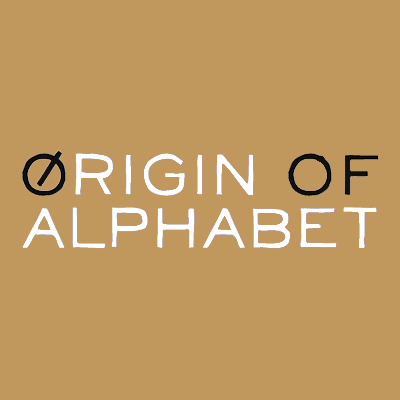
[…] Egyptians domesticated cats quite early, and even named the creatures after the sound they made – miw. There is also DNA evidence proving that cat descendent from Egyptian specimens were found […]
Thank you. This is very interesting and useful. Jennifer
Thank you. Very interesting.